By staff reporter ANNA SOWLEY
By staff reporter ANNA SOWLEY
IT is an unlikely place for a cutting-edge art complex: a small, dusty village, with a barber’s shop, a tiny restaurant serving dumplings, a convenience store, a school, and a little square with exercise equipment lining a deserted promenade. This sleepy village calls itself Qiaozi International Village Arts District, home to Qiaozi Art Commune, otherwise known as Shangyuan.
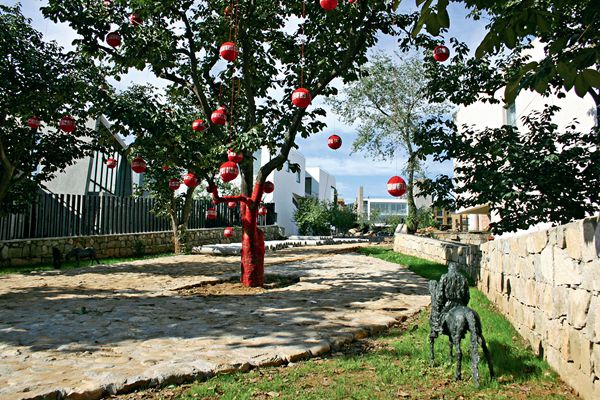
The rural location provides artists with a tranquil place to concentrate on art.
In this bucolic location, nestled amongst peach orchards at the foot of the Yan mountains north of Beijing, Shangyuan Art Commune is home to around 30 resident artists, including painters, sculptors, performance artists, musicians, and poets. It has residential buildings with simple but comfortable rooms, a library, a performance space, and a large gallery housing the commune’s permanent collection made up of works donated by previous residents. The rule is, you can live for free, but you must donate a piece of work to help fund the program. This gives people from all walks of life, especially those of limited means, the chance to dedicate all their time to the pursuit of art. Shangyuan was the first residency program of its kind – one which encompasses everything from cutting edge video art, mixed media, performance art, and installations, to more traditional mediums like painting, drawing, sculpture, and poetry.
Collective Effort
Poet Cheng Xiaobei founded Shangyuan with a group of fellow artists in 2007. After they leased the land, building the commune was a collective effort which took several years. Artists pitched in to help with funding, and even contributed to the physical labor of construction. They met with much skepticism from local residents at first, expressed through rubbish dumped at their front door, and even occasional break-ins and vandalism – all attempts to sabotage the project. Now, though, the local community has embraced them, even designating the village an arts district.
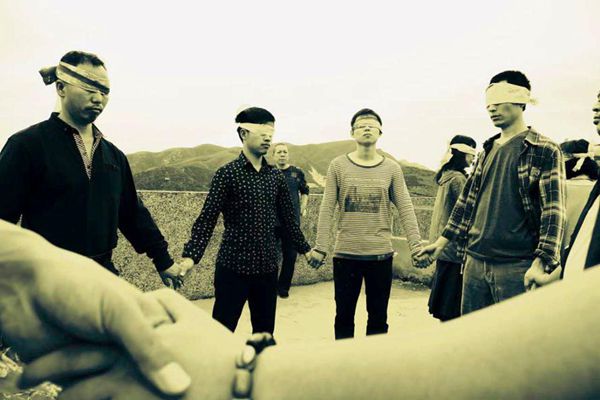
Performance art Obstacle by Spanish artist María Peña Coto.
Cheng Xiaobei is an omnipresent maternal figure, constantly supervising everything that goes on here – although she loathes being thought of as a teacher or even a leader. “This is not a school,” she insists. “We are all artists here.” A silver-haired, round-faced lady with thick round-rimmed glasses, she exudes energy – always on the move, gesticulating and talking – not your traditional idea of a poet. She dresses simply in a tunic and trousers, but accessorizes with a large necklace of wooden rainbow beads and a pink beaded bracelet. As we talk, she keeps fending off photographers eager to snap a shot of her at work. “Don’t take pictures of me,” she says firmly. And, after repeating this several times to different people, she sighs and swats the air with her hand: “like mosquitoes” she says, laughing.
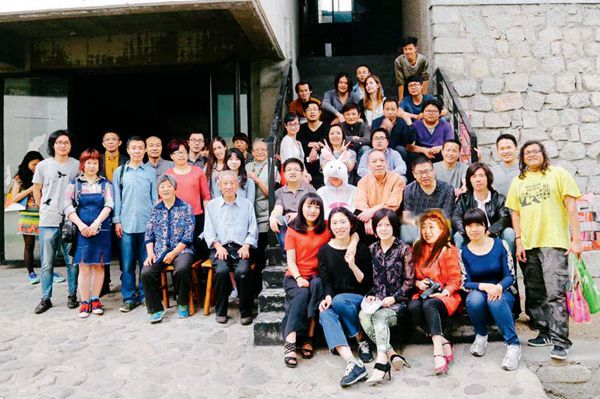
The Shang-yuan residency program encompasses everything from performance art to painting.
Striding about energetically, Cheng first gives visitors a tour of the complex, then meets the residents and oversees a modest opening ceremony for the exhibition of their newest works. In between, she finds time to spend 20 minutes practicing the guqin – the oldest known musical instrument in China, whose music entranced poets. It is a short moment of calm in the whirlwind of her day.
An Ancient Practice
There is a deep sense of tradition here – a desire to revive the ancient Chinese practice of communication between different artistic mediums. In ancient China, Cheng explains, it was common for poets to commune with musicians and painters to aid creativity. This is what she aimed to facilitate by founding Shangyuan, and yet she insists rather fiercely that this is not a revivalist movement per se, nothing to do with the grassroots movement which purposefully attempts to revivify China’s antique practices. Shangyuan is more about the value of the practice in itself and how it can help artists develop. The communing of people with different artistic approaches is a valuable pursuit and should never have been lost.
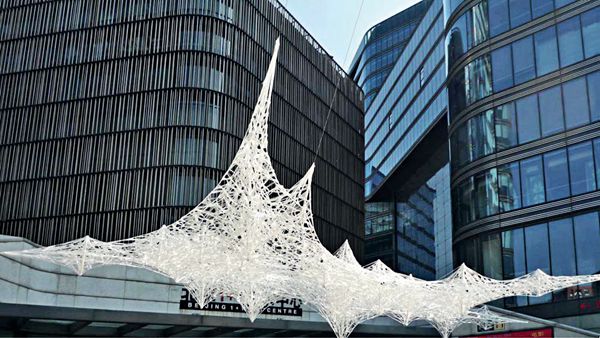
A piece by French artist Ludwika Ogorzelec.
The results of the application of this theory can clearly be seen in the works displayed in the latest residency exhibition, as well as in the pieces kept in the permanent collection. Many of the works seem to be exploring lost culture. Traditional symbols are hidden in complicated designs or combined in unexpected ways to form new images. Mythical Chinese monsters, lotus plants, clouds, and Chinese characters and seals peep out from behind multiple layers of multicolored paint. Sometimes what appears to be a traditional symbol or approach will, on closer inspection, prove to be something completely different – almost as though the symbol is purely superficial and does not bear close scrutiny.
Cheng introduces us to one of her favorite paintings, by Wei Pen, a former resident artist. At a distance, it appears a traditional composition of bamboo and rock. “Go a bit closer,” she says, and we dutifully shuffle forward. As we approach, the bamboo morphs into scaffolding held in place with iron shards, and the rock is in fact a misshapen lump of concrete, studded with rusty iron staples. “I particularly like this painting,” she says, reflectively, explaining that it embodies both a personal and a collective pain, confronting a deep sense of loss. In this particular painting she sees a profound wisdom.
This idea of collective pain is echoed by Su Menglei, the resident poet, as we make a tour of the exhibition together. “Good art is about pain,” he says, pausing to look at a painting in various shades of grey, “and happiness,” he adds, wryly, “a mixture of the two.” There is something about Shangyuan which is calculated to deliver both in equal measure. The rural location, basic facilities (one shared shower room, no outside lights), spartan living quarters and a lack of amenities, actually aids contemplation – a little discomfort makes for huge artistic gains. Hard work is the norm here, but there is always time for socializing. Many of the work sessions, such as the tri-weekly meetings to share ideas, the music rehearsals, concerts, and exhibitions, are so collective as to be naturally social events. There are also parties and communal dinners. Living here is no real hardship then, but a lot of fun. This careful balance helps each resident to carve a path of self-discovery, to achieve something new in their own work, or, if they are very ambitious, a “new thing” in China.
A New Thing
Most of the artists here are pursuing a new image or a new sound. Li Ke, an experimental interactive performance artist, has an alter-ego: “Rabbit.” Dressed in a white bunny suit, she interacts with a person chosen at random from the audience, using objects in her immediate environment to connect with the emotions which that person harbors internally. “I am empty,” she says, her smile just visible underneath the rabbit head. “I am a mirror.” She manages to evoke the most surprising reactions. Participants have described the Rabbit experience as extremely moving, often reducing them to tears as they feel an intense catharsis.
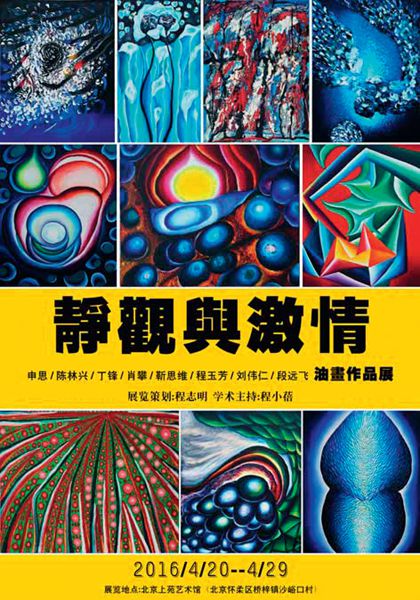
Calmness and Passion, an exhibition of eight painters, held at Shangyuan in April 2016.
During the opening ceremony the resident musicians, playing traditional Chinese instruments mixed with classical Western music, proceed to perform a musical bullfight, two violinists going head to head in mock battle, dancing their way across the floor as they create the most wonderful improvisation. The four musicians are multi-instrumentalists, and can perform just as beautifully on the erhu and pipa as they can on violin and cello. They are looking for a new sound – a fusion of cultures – and are tireless in their pursuit of it. Everyone living here is infused with immense creative energy.
After their performance, Rabbit runs riot. With the help of one of the visitors she proceeds to tie ribbons onto an installation, binds people with ropes, and tinkers with the band’s musical instruments until restrained and dragged off by a group of giggling residents. The scene is met with applause and laughter from the audience. Everyone is made to feel part of whatever “new thing” is happening here.
Holistic Benefits
Talking to the artists about what this sort of life entails, you get a strong sense of the holistic benefits – physical, mental, and artistic development. “I really got the chance to think about myself,” says Li Ke, reflecting on the quiet isolation of the commune. “You have no choice. This place puts you in this situation.” Despite being out in the middle of nowhere, there are plenty of opportunities to share ideas and explore different backgrounds and approaches through constant contact with the other resident artists. Maria, a painter and one of the few overseas residents, came here from Spain to live among Chinese artists and explore a new culture. She tries to find a connection with China through her work and involvement with the other artists. This exchange is vital to everyone who lives here, provoking a new artistic response.
“I meet the other artists every day,” Li Ke explains. “I know their characters, so I find the artists who can respond to me.” This collaboration is exactly what the commune encourages. Painters, writers, poets, and musicians respond to each other’s work and find inspiration for new creations. Many of the works in the exhibition are the product of a shared idea or a communal experience. Maria points out a pair of paintings on the back wall. A dimly lit scene of people crowding close together, one figure with raised arms, as if in worship. “That was done after one of our wild parties,” she says, smiling.
The artists habitually go for a walk together after dinner, so after the excitement of the exhibition opening and a small party to celebrate, we take our drinks out with us for a stroll. Next door is Zhang Yimou’s bizarre “folly,” a strange wooden pyramid structure set in fengshui gardens. The watchman allows us to take a brief look around before we take the path through the orchards, under the old railway bridge built by the Japanese nearly a hundred years ago. The heavy scent of lilacs and peaches drifts on the breeze. Although the air is polluted that day, the fragrance of blossom is almost intoxicating. The resident poet names all the trees as we walk, and the others caper arm in arm, laughing and talking. It is an idyllic scene.
As regards building a Utopia, these artists are doing a pretty good job; but art, as Cheng Xiaobei points out, is not for everyone. Or, more specifically, the artistic life – a quiet, contemplative existence – is not suited to everyone. One of the aims of Shangyuan is to provide a “genuine artists’ life experience” – one where artists can immerse themselves completely in their work, but also commune with others in a natural environment. The ancient poets I feel sure would have agreed that it is the perfect setting for creativity. And for those willing to mix a little pain with their pleasure, the rewards are boundless.